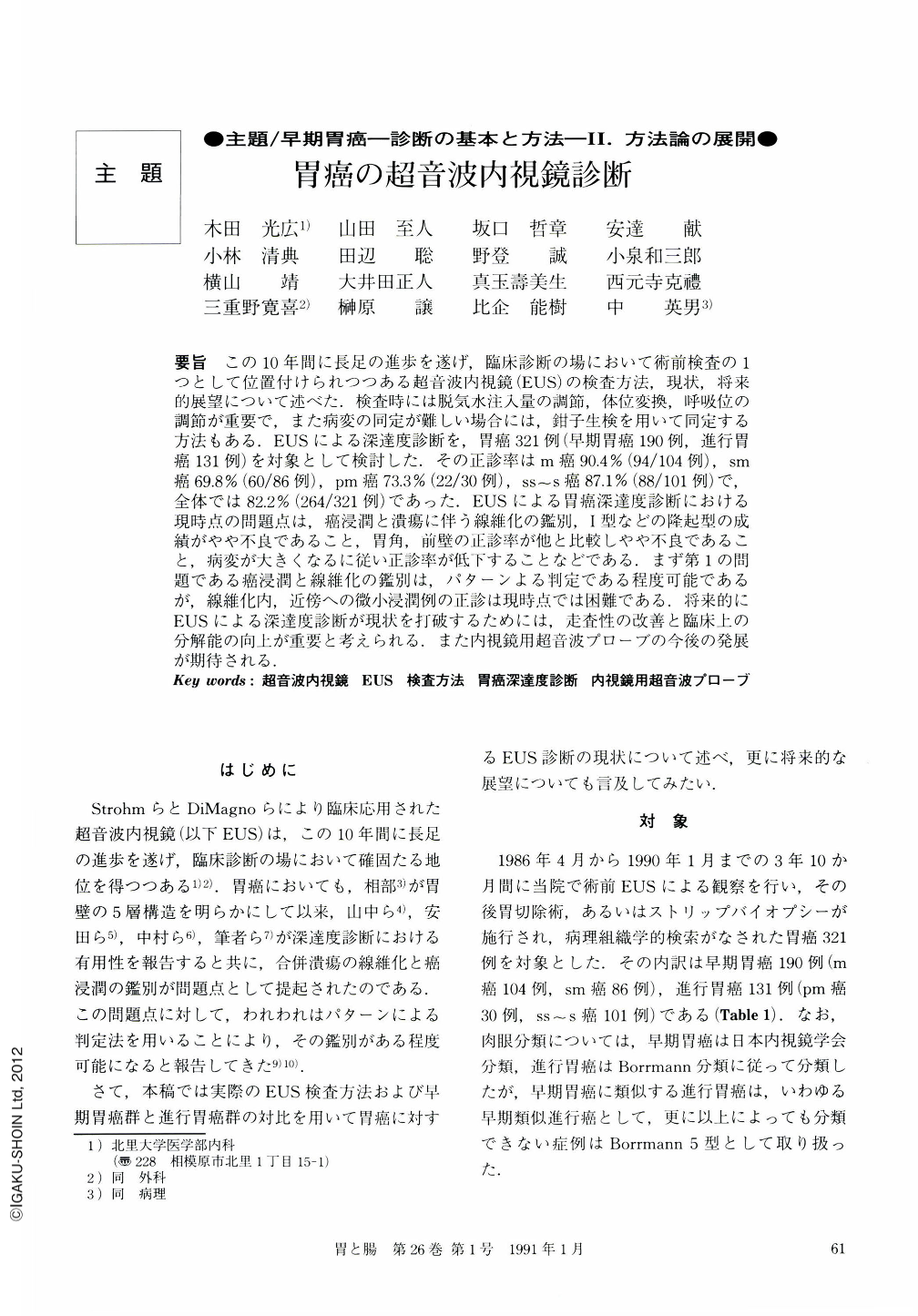Japanese
English
- 有料閲覧
- Abstract 文献概要
- 1ページ目 Look Inside
- サイト内被引用 Cited by
要旨 この10年間に長足の進歩を遂げ,臨床診断の場において術前検査の1つとして位置付けられつつある超音波内視鏡(EUS)の検査方法,現状,将来的展望について述べた.検査時には脱気水注入量の調節,体位変換,呼吸位の調節が重要で,また病変の同定が難しい場合には,鉗子生検を用いて同定する方法もある.EUSによる深達度診断を,胃癌321例(早期胃癌190例,進行胃癌131例)を対象として検討した.その正診率はm癌90.4%(94/104例),sm癌69.8%(60/86例),pm癌73.3%(22/30例),ss~s癌87.1%(88/101例)で,全体では82.2%(264/321例)であった.EUSによる胃癌深達度診断における現時点の問題点は,癌浸潤と潰瘍に伴う線維化の鑑別,Ⅰ型などの隆起型の成績がやや不良であること,胃角,前壁の正診率が他と比較しやや不良であること,病変が大きくなるに従い正診率が低下することなどである.まず第1の問題である癌浸潤と線維化の鑑別は,パターンよる判定である程度可能であるが,線維化内,近傍への微小浸潤例の正診は現時点では困難である.将来的にEUSによる深達度診断が現状を打破するためには,走査性の改善と臨床上の分解能の向上が重要と考えられる.また内視鏡用超音波プローブの今後の発展が期待される.
Endoscopic ultrasonography (EUS) has opened up a new era in imaging diagnosis of gastrointestinal disease and it's performance has been improved over the last 10 years. We studied the diagnosis of gastric cancer by EUS and investigated it's usefulness, limitation and prospects for the future. We have performed EUS in 321 patients with gastric cancer that underwent surgical operation from April 1986 to January 1990. The instruments which we have employed in this study were GF-UM2 (7.5, 10.O MHz), GF-UM3 (7.5, 12.O MHz), XJF-UM3 (12.0 MHz) and Ultrasonic Probe (UM-1W, 7.O MHz) manufactured by Olympus-Aloka Company.
In the present study, important technical aspects during the procedure included the volume control of intragastric water, position changing and proper breath holding. The biopsy forceps were used in cases where the lesion could not be easily identified. The rate of correct diagnosis by EUS regarding the degree of gastric cancerous invasion was 90.4% (94/104 cases) in the m-cancer, 69.8% (60/86 cases) in the sm-cancer, 73.3% (22/30 cases) in the pm-cancer and 87.1% (88/101 cases) in the ss ~ s cancer, respectively. Ultrasonographic pattern analysis was useful in the depressed type (Ⅱc+Ⅲ, Ⅱc) of early gastric cancer, and the depressed type (Ⅱc+Ⅲ_like, Ⅱc_like) of advanced gastric cancer when applied for the sake of differential diagnosis between cancerous invasion and fibrosis of coexisting ulceration. The correct diagnostic rate of the former and the latter was 74.2% (49/66 cases), 72.2% (39/54 cases), respectively. However, there are some problems involved in the diagnosis of the depth of gastric cancerous invasion by EUS. They are;
1) The minute invasion of intra-or para-fibrosis could not be detected ultrasonographically in ulcerationcomplicated gastric cancer, even if the pattern analysis was used.
2) The correct diagnostic rate by EUS was not verified satisfactorily in polypoid type gastric cancer because of ultrasonographic attenuation and artifact.
3) The correct diagnostic rate for lesions of the angle and the anterior wall of the stomach was also not verified satisfactorily when compared to other regions.
4) As the diameter of a lesion increased, the correct diagnostic rate by EUS became less.
These problems should be able to be overcome by technical improvement of EUS as regards flexibility, and the resolution of the longitudinal axis at clinical examination. Ultrasonic probe will be useful in the near future. Nevertheless, we believe that EUS is one of the most reliable techniques at present for the diagnosis of the depth of gastric cancerous invasion.

Copyright © 1991, Igaku-Shoin Ltd. All rights reserved.


